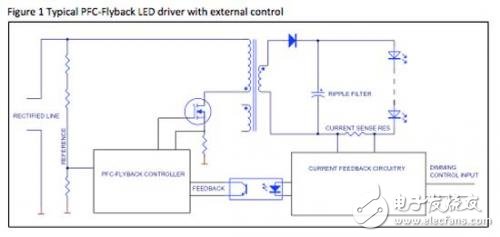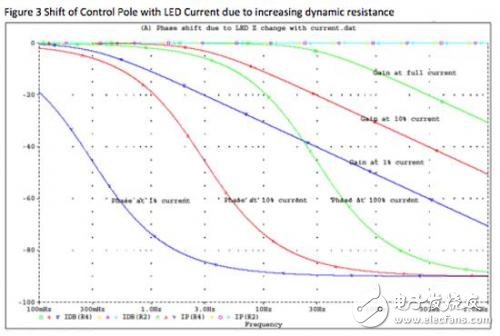The dimming LED driver will have light output stability problems at low light levels. This article will explore the root cause of this problem and propose a solution. This article does not discuss the dimming technology of bidirectional thyristors, because the low light instability is caused by different mechanisms. Dimming methods for setting LED current using communication technology include DALI, 0-10V, Zigbee and power line carrier control.
The LED driver receives a signal and uses it to set the reference current. At the same time, the control loop adjusts the LED current to match the reference current. Only with high control precision can the brightness of adjacent lamps be the same. The flickering and low light phenomenon at low light levels confuse designers.
Single-stage power factor correction
If a two-stage power converter is used, low light intensity instability will occur again. The first stage (boost or PFC-flyback) establishes a more stable voltage, and the second stage (usually a buck inverter) precisely regulates the current in the LED. Because more components are required, the energy efficiency of the two-stage solution is not as good as that of the single-stage converter. For cost considerations, LED manufacturers usually choose single-stage PFC-flyback converters.

problem
The dimming should be at least in the 20 range, providing this range of light quantity. The incandescent lamp has no problems. At low light power, the energy efficiency of the incandescent lamp is greatly reduced. The power range required in the 20 light quantity range is relatively narrow. If 40% voltage or current is supplied, the light output will drop to about 1%. The market expects LED to solve this problem.
The linear response of LEDs is much better than incandescent lamps. At low currents, the energy efficiency is higher. The human eye can discern the 5% difference between adjacent light sources and only responds to the difference expressed as a percentage, while the absolute amount of light does not cause the human eye reaction. This requires strict control of the current. At low light levels, the control accuracy requirements are higher. If you need to adjust to 1% of full output, you cannot use primary control.
Unlike incandescent lamps, LEDs have no self-filtering mechanism. The thermal capacity of the filament of an incandescent lamp is a good AC filter, while the LED requires an external filter circuit. A common solution is to connect a large electrolytic capacitor directly to the LED, and the filtering effect is good.
The capacity of the electrolytic capacitor is determined according to the requirements of light ripple. If the ripple current is less than 10% rms (approximately 28% pp), the human eye feels that the light quality is the same as pure DC. (In addition, if the ripple current is higher than 10%, the ENERGY STAR logo requires a statement on the lamp.)
LED has a dynamic resistance (slope resistance), its size is about 1/10 of the apparent V / I resistance. Figure 2 shows the VI curve of a typical LED.

Therefore, if the ripple current is less than 10% RMS, the capacitor must control the voltage on the LED within 1%. The required values ​​are:

Unfortunately, the capacitor is still part of the control loop. The capacitor and LED dynamic resistance set the control loop pole to about 30 Hz. Therefore, at this frequency, the capacitance increases by 45 degrees of phase lag, reducing the loop gain by 6dB. We will discuss this issue later. The figure below details the gain and phase shift due only to the polarity point of the LED control loop.

Note that the dynamic impedance of the LED increases as the current decreases. Unfortunately, this moves the control loop pole to the left. At 10% current, the corner frequency is about 3 Hz. At 1% current, the corner frequency is about 0.3 Hz. Note that for the PFC stage, a typical control loop has a crossover frequency of 3Hz to 20Hz.
It is unreasonable to design a control loop whose pole is movable within this range. The only feasible solution is a design with a crossover frequency of 0.03 ~ 0.1Hz, but the control loop will become very slow.
The lithium Battery Protection Board is the charge and discharge protection for the series-connected lithium battery pack; when fully charged, it can ensure that the voltage difference between the individual cells is less than the set value (generally ±20mV), so as to realize the equal charge of each single cell of the battery pack. , effectively improving the charging effect in the series charging mode; at the same time, it detects the overvoltage, undervoltage, overcurrent, short circuit, and overtemperature status of each single cell in the battery pack to protect and prolong the battery life; undervoltage protection makes each A single-cell battery is used to avoid damage to the battery due to overdischarge.
Lithium Iron Battery,Lithium Iron Battery Board,Industrial Control Board,Medical PCBA Board,Circuit Board Assembly
Huizhou Liandajin Electronic Co., Ltd , https://www.ldjpcb.com
